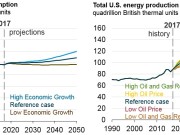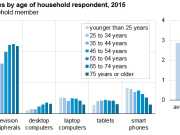EIA publishes its first energy-sector forecasts through 2026
The U.S. Energy Information Administration (EIA) published its first forecasts for energy production, consumption, and prices through 2026 in its January
EIA expects rising electricity demand and natural gas prices to affect electricity fuel mix...
The U.S. Energy Information Administration (EIA) expects that the United States will generate more electricity from renewables and coal in the second half of this year, as electricity demand and
Space heating consumed the most energy of any end use in homes, according to...
Space heating continued to be the top energy-consuming end use in U.S. homes in 2020 according to the Residential Energy Consumption Survey (RECS). Heating homes accounted for 42%
EIA projects that increased electrification, higher equipment efficiencies, and more zero-carbon power sources will...
U.S. energy-related CO2 emissions drop 25% to 38% below what they were in 2005 by 2030, according to projections from the U.S. Energy Information Administration’s (EIA) Annual Energy Outlook 2023 (AEO2023).
EIA lowers U.S. natural gas price forecast after a warmer-than-average start to 2023
The U.S. Energy Information Administration (EIA) expects natural gas prices at the Henry Hub to average around $3.40 per million British thermal units in 2023, 47% lower than in 2022. According
International Energy Outlook 2019 projects nearly 50% increase in world energy usage by 2050,...
In its International Energy Outlook 2019 (IEO2019), the U.S. Energy Information Administration (EIA) projects that world energy consumption will grow by nearly 50% between 2018 and 2050. EIA projects most of this growth will come from regions where the consumption of energy is driven by strong economic growth
Robust energy production growth coupled with relatively flat U.S. demand support net energy exports...
The U.S. Energy Information Administration (EIA) released today its Annual Energy Outlook 2018 (AEO2018), which includes its Reference case and a number of sensitivity cases. The AEO2018 Reference case shows continued development of the U.S. shale and tight oil and gas resources paired with modest energy consumption growth, leading to the transition of the United States from a net energy importer to a net energy exporter across most cases examined in AEO2018. "The United States energy system continues to undergo an incredible transformation," said EIA Administrator Linda Capuano.
2017 EIA Energy Conference
The EIA Energy Conference has become a premier forum for addressing energy issues in the United States and around the world. This event will bring together thought leaders from industry, government, and academia to discuss current and future challenges facing domestic and international energy markets and policymakers.
Latest data show changing household energy characteristics
An average of 2.3 televisions were used in American homes in 2015, down from an average of 2.6 televisions per household in 2009, according to the Residential Energy Consumption Survey (RECS), released today by the U.S Energy Information Administration (EIA). The number of homes with three or more televisions declined from the previous survey conducted in 2009, and a larger share of households reported not using a television at all.
EIA’s AEO2017 projects the United States as a net energy exporter in most cases
Annual Energy Outlook 2017 (AEO2017), released today by the U.S. Energy Information Administration (EIA), presents updated projections for U.S. energy markets through 2050 based on eight cases (Reference, Low and High Economic Growth, Low and High Oil Price, Low and High Oil and Gas Resource and Technology, No Clean Power Plan implementation). This is the first time that EIA is publishing projections through 2050 in the AEO tables.
EIA presents updated long-term energy projections
EIA presents the findings of Annual Energy Outlook 2017 with projections of U.S. energy supply, demand, and prices including cases that address alternative assumptions regarding U.S. economic growth rates, domestic energy resources and technology, world oil prices, and the Clean Power Plan.














